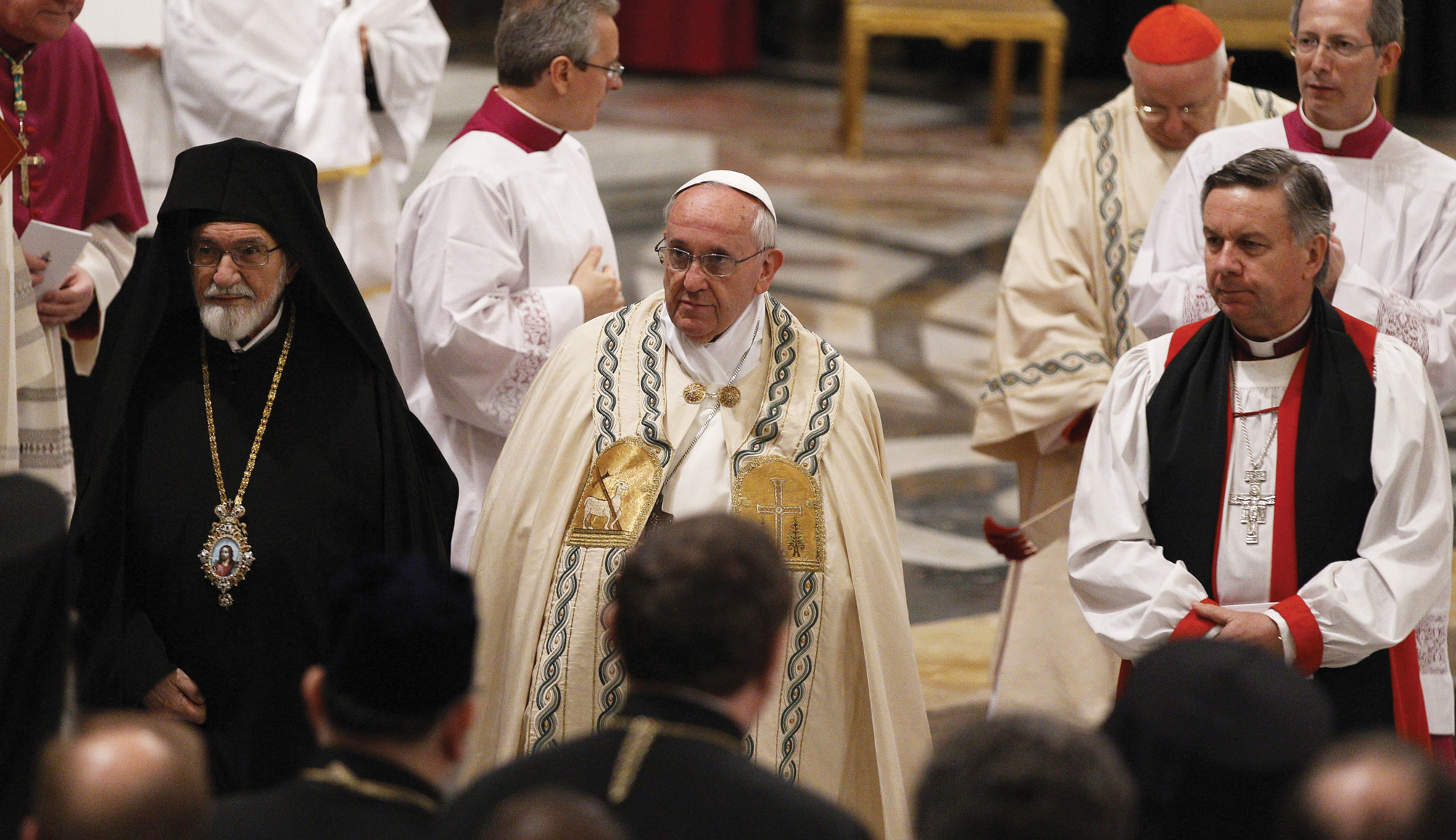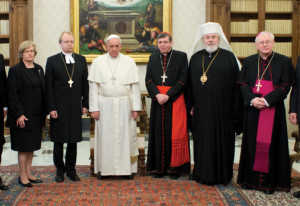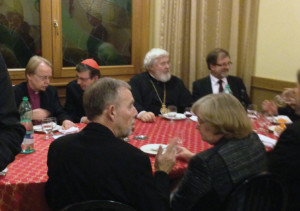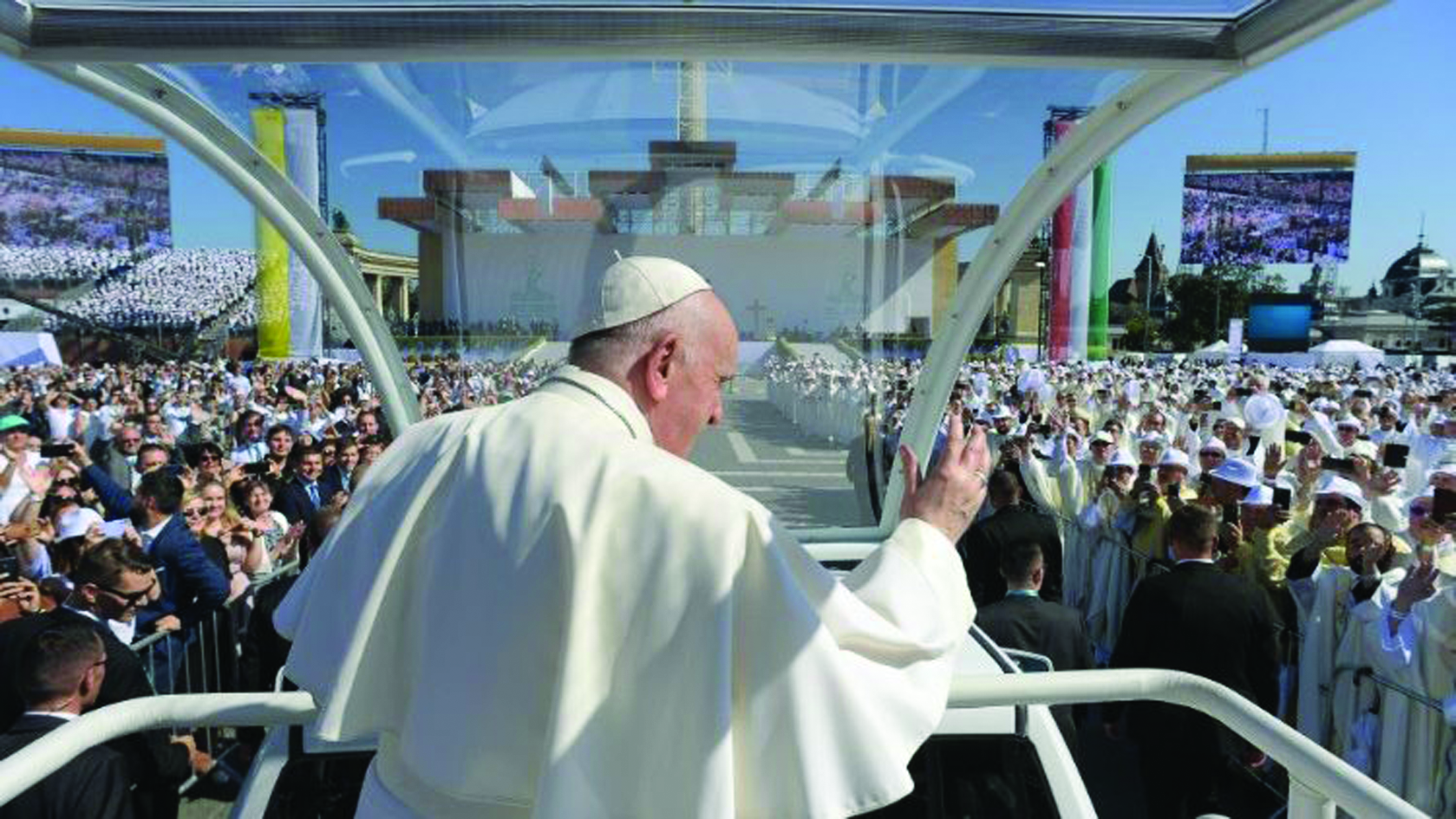Pope Francis greatly desires to bring all believers in Christ closer together, to overcome the divisions of past centuries. He sees the role of the successor of Peter in that work as critical…

January 25, Ecumenial Prayer Service, St. Paul’s Outside-the-Walls: Orthodox, Anglican, Lutheran, Methodist and other Christian representatives present read some of the prayers, while Pope Francis presided over the prayer service.
“An essential dimension of the ministry of the Bishop of Rome” is fostering Christian unity, up to the point that “today the Petrine ministry cannot be fully understood without this openness to dialogue with all believers in Christ.” These words of Pope Francis in his homily during the celebration of Vespers on the Solemnity of the Conversion of St. Paul in the Roman Basilica of St. Paul’s Outside-the-Walls on Saturday, January 25, to end the Week of Prayer for Christian Unity (January 18-25), go a long way to show how crucial ecumenical engagement is for his pontificate. “We can say also that the journey of ecumenism has allowed us to come to a deeper understanding of the ministry of the Successor of Peter, and we must be confident that it will continue to do so in the future,” Pope Francis went on. “As we look with gratitude to the progress which the Lord has enabled us to make, and without ignoring the difficulties which ecumenical dialogue is presently experiencing, let us all pray that we may put on the mind of Christ and thus progress towards the unity which He wills. And to journey together is already to be making unity!”
The pontiff is convinced that “unity will not come about as a miracle at the very end” but that “rather, unity comes about in journeying; the Holy Spirit does this on the journey.” He said: “If we do not walk together, if we do not pray for one another, if we do not collaborate in the many ways that we can in this world for the People of God, then unity will not come about! But it will happen on this journey, in each step we take. And it is not we who are doing this, but rather the Holy Spirit, who sees our goodwill.”
The theme of this year’s Week of Prayer for Christian Unity, was a theme suggested by a group of Christians based in Canada: “Has Christ been divided?” (1 Cor 1:13) — the urgent question of St. Paul at the beginning of his First Letter to the Corinthians as he appealed for unity. But the communion among the followers of Christ for which the Apostle was pleading, Pope Francis said, “cannot be the fruit of human strategies. Perfect union among brothers and sisters can only come from looking to the mind and heart of Christ (cf. Phil 2:5). This evening, as we gather here in prayer, may we realize that Christ, who cannot be divided, wants to draw us to himself, to the sentiments of his heart, to his complete and confident surrender into the hands of the Father, to his radical self-emptying for love of humanity. Christ alone can be the principle, the cause and the driving force behind our unity.”
Pope Francis also recalled that “we may not regard divisions in the Church as something natural.” Citing Vatican II in decrying divisions among the followers of Christ, he pointed out that this state of affairs “openly contradicts the will of Christ, scandalizes the world, and damages the sacred cause of preaching the Gospel to every creature.” That’s why St. Paul, in his letter to the early Christian community at Corinth, condemned divisions of all sort and therefore “Paul could not even praise those who claimed to belong to Christ, since they were using the name of the one Savior to set themselves apart from their other brothers and sisters within the community,” the pontiff said.
The “Has Christ been divided?” theme was also recalled by Pope Francis on January 17, 2014, when he warmly received, as is by now a tradition, an ecumenical delegation from Finland led by the head of the Evangelical Lutheran Church of Finland, Archbishop of Turku Kari Mäkinen; the head of the Orthodox Church, Archbishop Leo of Karelia and All Finland; and the Catholic bishop of Helsinki, Msgr. Teemu Sippo.
These Nordic representatives were in Rome for another tradition, which this year celebrated its 25th anniversary: the annual pilgrimage to honor St. Henrik of Uppsala, the martyr patron saint of Finland, whose feast day is January 19.
Pope Francis urged them to continue working for the goal of full, visible unity among Christians. He noted that the question put by St. Paul to the divided Christian community in Corinth, has Christ been divided, applies also to ourselves today, in the face of those who no longer see the full, visible unity of the Church as an achievable goal.
Nevertheless, he stressed, we must not weaken our ecumenical efforts. “At the present moment, the ecumenical path and relations among Christian are undergoing significant changes due primarily to the fact that we must profess our faith in the context of societies and cultures where reference to God, and everything that recalls the transcendent dimension of life, is always less present,” the Pope said. “We notice it especially in Europe, but not only in Europe.”
In other words, relations between Christians are also affected by the fact that they are professing their faith in a culture which is increasingly marginalizing any reference to God or to the transcendent dimension of life. Therefore, he said, our witness must be based on love, in order to grow in communion and unity.
“For 29 years now, the Mass of St. Henry at the church of Santa Maria sopra Minerva in Rome has been part of the Finnish observance of the Week of Prayer for Christian Unity,” Archbishop Mäkinen said in his address to the Pope. “In alternate years, the Mass has been presided over by either a Catholic or a Lutheran bishop, with the preacher being a bishop of the other tradition.”
Since its inception, he went on, this celebration has been seen as an “opportunity to bring the greetings of Finnish Christians to the Holy Father, and we greatly value the fact that you, Your Holiness, have wanted to continue this tradition.” The leaders of Finland’s three historic Christian traditions have always participated in this event, as also shown by their presence this year. “Our shared visit is the natural response of Finnish ecumenism to St. Paul’s question, ‘Has Christ been divided?’ No! we reply, as we journey together as followers of Christ.”

From Finland to Rome (from left to right): the Lutheran Archbishop Maekinen, Pope Francis, Cardinal Koch, the Orthodox Archbishop Leo and the Catholic bishop of the capital, Helsinki, Teemu Sippo.
The Finnish prelate, on behalf of the Christians of Finland, presented the Holy Father with a copy of a painting “Armo” (“Grace”) by Finnish artist Osmo Rauhala. It is a copy of the original from the restored medieval church of St. Olaf in Tyrvää, which was destroyed by fire in 1997. Rauhala was one of two artists entrusted with the task of producing new paintings for its interior and his work depicts two little creatures of God, a bird and a fish: a sparrow feeding a pike. “The boundary between air and water is broken; the border between two worlds overcome. Grace crosses borders and breaks down barriers,” he noted, referring to the highly symbolic significance of the scene. “It overcomes the world founded on the survival of the fittest and the pursuit of self-interest. It is a picture of grace; of discipleship; of the power of God present in the little, the poor and the simple.”
As Finnish Christians, he concluded, “we rejoice that you, Holy Father, have encouraged us with your words and actions to hear Christ’s voice in the little, the poor and the simple” and “we wish to assure you of our prayers that Almighty God may grant you the power, courage, wisdom and love required for your invaluable ministry of crossing borders and building up the unity of the Church.”
In this Nordic dimension of the Week of Prayer for Christian Unity, the Bridgettine Order led by their abbess Mother Tekla Famiglietti fulfills a prominent role by hosting in their headquarters, the Casa di Santa Brigida, and participating in a number of closely-related religious initiatives.

At dinner, Cardinal Kurt Koch was present throughout.
The day after the audience of the Finnish delegation with the Holy Father, the Order’s church hosted the celebration of an ecumenical vespers on Saturday evening, January 18, 2014, again (as was also the case the previous year) presided over by the president of the Pontifical Council for Promoting Christian Unity, Cardinal Kurt Koch, who also joined the subsequent convivial function, sitting in a warmly fraternal conversation with the other three senior prelates from Finland. Among the various diplomatic, political and cultural authorities in attendance, a top Finnish political figure stood out in particular, the Vice-President of the European Commission and member of the Commission responsible for Economic and Monetary Affairs and the Euro, Olli Rehn.
After “two frenetic days in Beijing,” he chronicled in his blog under the headline “Ekumeenista sillanrakennusta Roomassa” (“Ecumenical bridge-building in Rome”), “on January 16 I began a short visit to Rome. Needless to say, there is a striking contrast between the capital of the world’s largest emerging economy, a place of constant transformation for the past three decades, and the timeless majesty of the ‘Eternal City.’” His mission to Italy, he said, “was an ecumenical one, both spiritually and politically. Spiritually, the highlight of the mission was certainly Saturday evening’s Ecumenical Vespers at the St. Maria Church and St. Birgitta Convent,” where “the Archbishops of the Evangelical-Lutheran and Greek-Orthodox Churches of Finland, Kari Mäkinen and Leo, and the Catholic Bishop of Helsinki, Teemu Sippo, performed the ceremony with sanctity and elegant simplicity.” He went on to also recall that “the event took place on St. Henry’s day, which symbolizes the Christianization of Finland some 850 years ago. It was followed by a supper kindly hosted by Sister Marja Liisa and her colleagues. In the end, we asked the Salo Church Choir to perform Finlandia, and there was no dry eye in the house.” But there is more, since he also reported that “another event of European bridge-building — this time North-South — took place in Villa Lante, the Finnish Cultural Institute in Rome” where “Dr. Alpo Rusi, Finnish Ambassador to the Holy See and Switzerland, gave an interesting talk on Finland’s diplomatic relations with Vatican and the pursuit of peace in 1943-44. We had earlier met with Monsignor Camilleri of the Holy See to discuss topical foreign policy matters.”
Interestingly, a significant precedent of this visit by Finnish dignitaries took place in June 2011, when the then-Finnish president Tarja Halonen, while in Rome at that time as head of one of some 80 foreign delegations participating in the celebration of the 150th anniversary of Italian unity, was reported to have paid an unexpected visit to Casa di Santa Brigida, due to her interest to know more about the Bridgettine Order.
But this year’s involvement of Casa di Santa Brigida went far beyond hosting the vespers and the ensuing supper. Besides holding a prayerful session every day throughout the Week of Prayer starting with the rosary at 4 pm followed by reflections on ecumenism, vespers and Eucharistic benediction, the Bridgettine nuns hosted the reception, with refreshments being generously made available and served as a communal meal in their refectory, following the Mass in memory of St. Henry, celebrated as usual in the Finnish National Chapel in the Church of Santa Maria Sopra Minerva in Rome on the St.’s Day, January 19, which this year fell on a Sunday. And this year it was the turn of the Catholic Mass, celebrated by Msgr. Sippo, and the homily being given by Archbishop Mäkinen. In his homily he drew a parallel between the trajectory of St. Henry’s life, which was crowned by martyrdom on Finnish soil, and current events around the world, comparing the tragic fate of the Saint, who was British-born, and the mishaps migrants have to face today.
Thus, “Henry’s memory is alive now, as we, Catholics, Lutherans and Orthodox, of different nationalities and backgrounds, gather for this celebration of his feast,” he concluded.
In light of these words, a recent development can also be seen as part of St. Henry’s legacy and as a tangible result of that concrete, practical collaboration hinted at by Pope Francis in his homily at the Vespers which wound up the Week of Prayer for Christian Unity in St. Paul Outside-the-Walls: the official opening of the first Catholic church in Kuopio, the capital of Savo province in central Finland, on May 3, 2014, as reported in the January issue of the official journal of the Helsinki diocese, Fides, and personally confirmed by Msgr. Sippo in Rome.
The church will be dedicated to St. Joseph and is due to initially function as a chapel in the district of St. Olav’s parish church, which is located some 150 km (slightly over 90 miles) away in Jyväskylä, with Mass scheduled to be celebrated once or twice a month.
The church was not built from scratch, but is a pre-existing Evangelical-Lutheran church, the Männistön vanhan kirkko (named after the area of the city, Männistö), which the Evangelical Lutheran Church sold to the Catholic Church on November 27, 2013, for €800,000 (more than $1 million). It is obvious that the newly-purchased building, though in rather good condition, will have to be suitably renovated and adapted for it to be turned into a full-fledged parish church, hopefully in a not-too-distant future. The deal was made possible by the generosity of a donor, who preferred not to be identified.
If the Evangelical Lutheran church had come to the painful decision to sell the building due to financial constraints, they were more than happy that it was purchased by the Catholic Church and thus could continue being used for religious purposes. For his part the head of the Catholic Church in Finland, Bishop Sippo, was quoted as saying that “we were warmly received” and “I would also like to emphasize the church doors remain open to all those who would like to come in” for prayerful recollection.
According to latest available figures, Finland has the lowest proportion of Catholics in all of Europe, 0.22%, numbering almost 12,000 out of a population of over 5 million people. Nevertheless, as also reflected by the establishment of this new church in Kuopio, the Catholic Church has grown considerably, from about only 3000 faithful 30 years ago. A growth which is not only due to immigration: for example Timo Soini, presidential candidate and the leader of the main opposition party in Parliament, Perussuomalaiset (in English, the “Finns Party” or “True Finn Party”), is a practicing Catholic who has come under media fire for his open pro-life and pro-family standpoints.
Kuopio, with a population of over 100,000 which makes it the eighth largest city in the country, was founded in 1653 by Governor Peter Brahe, but officially proclaimed a city by King Gustav III of Sweden on November 17, 1775, when at the time Finland was still under Swedish rule. Since the Reformation was introduced in mid-1500s, it would seem that this is the first Catholic church ever built there. Interestingly, Kuopio is home of the Finnish Orthodox Church, that has the second largest following after Lutheranism, whose primate, archbishop of Karelia and all Finland Leo (Makkonen), has his see there. An autonomous cell within the autocephalous jurisdiction of the Patriarchate of Constantinople, this is the only mainstream Orthodox denomination to celebrate Easter on the Latin date and the Catholic community has been able to celebrate its liturgy once a month in a room-turned-chapel fraternally made available precisely by Archbishop Leo in the parish complex where the Orthodox cathedral is located. Meanwhile, ahead of the May 3 official opening, this celebration has already been moved to the new church of St. Joseph.






Facebook Comments